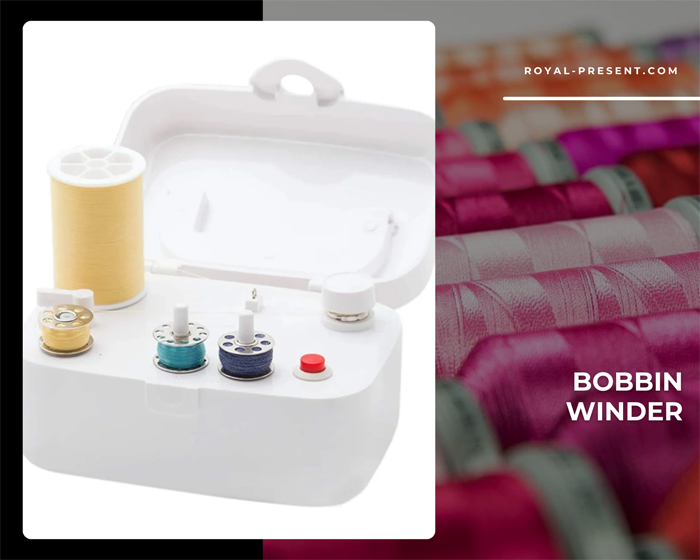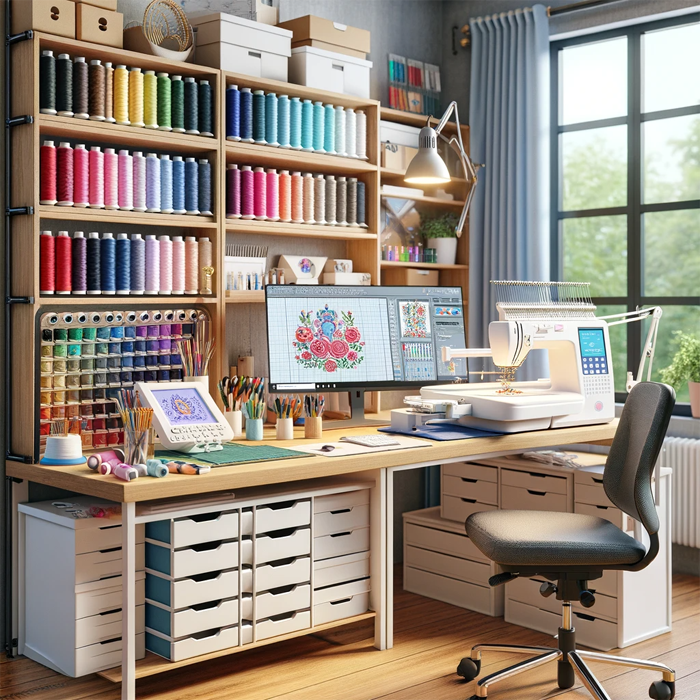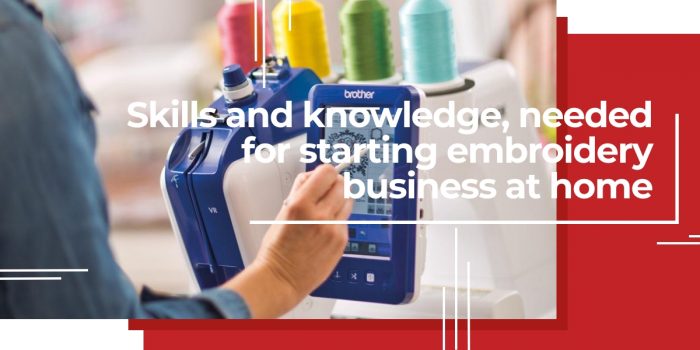Welcome to another portion of the information concerning home embroidery business organization. The present installment, the fourth in the series of articles on home-run embroidery business, deals with the skills and knowledge that an embroiderer should have to succeed.
- What is there besides operating embroidery machines that you need to know?
- Is there any special equipment that you might require as well?
- What is this digitizing thing that everyone in the trade is talking about?
- Will your professional knowledge and skills be enough, or should you also acquire some general business knowledge?
Questions, questions, questions… Answers to all of them, plus little extras, will be given in the following order:
1 – Skills and knowledge specific to machine embroidery:
- Design editing and digitizing,
- Computer skills,
- Knowledge of fabric and other embroidery materials,
2 – General business knowledge:
- Planning skills,
- Managing skills (in general),
- Time managing skills,
- Communication skills (for client service).
3 – Equipment, needed for home-run embroidery business:
- Basics (embroidery machine, computer, printer and materials),
- Additional equipment (equipment which will make your working space more comfortable and general business equipment).
So, let us begin…
Machine embroidery skills and knowledge
Design editing and digitizing for home embroidery business
Design editing skills are really important. Resize, recalibrate, add or remove certain parts of designs, add monograms to frames and otherwise – all these comes into the category of “design editing skills”. Everyone who’s seriously into embroidery as business should know how to do at least basic design editing. Basic design editing can be done in an embroidery machine (if it has such feature). More complex design editing requires special software. Some of such software is free. Other editing software should be bought.
Skills and knowledge, needed for starting embroidery business at home
NOTE: Make sure you make your research before buying any software. Don’t get tricked into buying software that can be downloaded for free from official internet sites of most manufacturers. Also, make sure you know what for you need the software you’re going to buy. Some programs will help you only convert your designs from one format to another. Other programs are for design editing only. Then there’re also types of programs for making designs (digitizing). If you’re not sure which one you will actually need, get a consultation from your dealer or at least internet embroidery forums.
Design editing skills are not hard to acquire. All you need to do is to learn the manual of your machine very well and practice embroidery often. Now, digitizing skills on the other hand is an entirely different story. You need to learn how to navigate the program first. Then you need to learn how to actually use it. It’s great to be able to digitize, but it takes quite a lot of time to learn it. Many embroidery entrepreneurs don’t have or use digitizing skills in their work. Of course it’s quite rewarding to see your own design to be worn by your customers, but the truth is it’s not time-efficient.
Example: Your schedule says that you have an order for embroidering of a large amount of towels and then right after it another one for napkins. So, for the first one you want to make your own design (digitize). Digitizing takes time. Downloading a design and editing it, if needed, can be much quicker. If you digitize, it’ll take you much longer to complete the order and moving on to another. This means that you’re probably not prioritizing things right and, thus, losing money.
Computer skills
You’ll need computer skills in machine embroidery for a lot of things:
~ Design editing and conversion is done with the help of a computer,
~ Designs are stored in a computer (thus you also use them for transferring designs to the machine),
~ Online transactions are done through a computer (buying supplies, managing media accounts, communicating with clients, e-mails etc).
~ Lastly knowing how to operate a computer helps a lot in navigation of an embroidery machine.
Knowledge of fabric and other embroidery materials
You absolutely must know how different materials behave during the embroidery process to have any decent results. This includes knowledge of stabilizers (and stabilizing sprays too), needles, threads, fabrics etc. Then there’re such issues as tension adjustment, speed adjustment etc. These issues are closely connected to the materials and types of designs. What gives you such knowledge? Practice and experience do.
General business knowledge:
Planning skills
Planning skills are needed in every business. However, as we’re speaking of home type of enterprise (which usually means that it’s run by only one person), the issue is even more pressing. You’ll need planning skills not only for making business plan in the beginning. (By the way, business plan can be made with the help of a specialist.) Later, however, when you’ll be dealing with orders you’ll need to know how to plan your working schedule months ahead. There’re a lot of tools (planning books, online tools, software) which help plan and organize working process. Also, there’re coaching programs, created specifically for embroidery businesses.
Managing skills (in general)
It’s impossible to run a business without managing skills. As home embroidery businesses are mostly one-man operations, you’ll find yourself managing your own work. This means that you’ll need to look really carefully into your work to see any possible flaws.
Example: You’re behind your schedule with orders. Do you need to hire help? If yes, what type of help do you need to hire? Think through all the options: outsourcing, temporal help, part-time help etc. May be it’s not help that you need but an upgrade of the equipment? What about delivery of the finished product? All these questions should be answered and managing skills help a lot with the answers.
Time managing skills
If you want to succeed you must know how to manage your time right. As you work at home, there’ll be “domestic” destructions, which might steal your attention and time from the working process. To avoid such destructions, you’ll need to set certain rules.
Example: You set a working “shift” of 4 hours free of any other activities (walking a dog, snacking, browsing Instagram etc.) Planning skills will help managing your time.
Also, timing skills is greatly needed when you take up orders months ahead (especially during holidays).
Example: Christmas orders are the ones that require a lot of attention. There’re last minute orders. There’s shipping time to be taken into account. There’s always some sort of force majeure issues too. So, timing skills (combined with the planning skills) are absolutely necessary.
Communication skills (for client service)
Even if you are a real expert in machine embroidery, you can’t succeed as an entrepreneur without communication skills. This type of skills helps not only in finding new clients, but also in keeping the already existing ones coming back. We’ve already spoken about this type of skill in the article “How to find clients for embroidery?” so it’d waist of your time if we’d repeated it again. If you’d like to learn more on the subject, just check the article in our blog.
Equipment, needed for home-run embroidery business:
Basics (embroidery machine, computer, printer and materials)
As you probably remember, we’ve already discussed the so-called starter kit, needed for launching home-run embroidery business. For those, who don’t remember the topic was discussed in the very first part of the series. Well, besides the mentioned items, there’re also some extra materials, which are certainly worth to be added. The list of such extras consists of the following items:
~ Double set of hoops. You will need the second pair of the hoops to make the process of embroidery quicker. You’ll manage a lot more embroideries if, while one part is being stitched, you’ll be preparing (hooping and re-hooping) another.
~ Good variety of threads. What do we mean by “good variety”: 7 basic colors (the ones that are usually listed as “rainbow” colors) in their neutral, warm and cold variations (that’s 21 shades already). Plus, you’ll also need black and white colors. If your orders have to do mainly with photo-stitch projects (embroidering images of people, pictures etc), you’ll also need “skin” colors to match various skin types. Then don’t forget about the bobbin thread in at least two colors (black and white).
"
Bobbin winder
~ Bobbin winder. If you can’t use your machine to wind bobbins, separate or even portable ones can stand in perfectly well.
~ Scissors. You’ll need several types: embroidery snips, appliqué scissors and regular crafting scissors. You might also consider getting a seam ripper tool (especially if you don’t have the snips). We didn’t mention tailor’s scissors (or dressmaker’s shears), for it’s mostly for sewing and if you sew, you’ve probably already have them.
Electric Seam Ripper
~ Seam ripper (automatic, electric etc.) Sometimes scissors just won’t do. One of such cases is when you need to clean up a really massive lot of stitches.
Example: You’re embroidering a shirt and you’ve mistaken left part of its front with the right. Another bad case is when you mistake top part of an item with its bottom part and sew a design in the wrong place. Then, there’re also mishaps with alignment of design’s parts.
If you’ve seen the mistake only too late, when the design is already finished, you’ll have to re-do the entire thing. Imagine how long it will take you to rip all of the seam! So, automatic or electric seam ripper (e.g. Whal, Quck Reaper etc.) can cut all the seams a lot quicker than you. All you need to do afterwards is to clean all the threads. Some use for the cleaning part sticky tape or simply remove the cut threads with tweezers.
~ Stabilizers. In the beginning you’ll definitely need such types as: cut-away (medium), tear-away (medium) and a water-soluble one. Later, when you’ll know what type of orders you’ll be dealing with mostly, you can buy stabilizer in bulk.
~ Iron or ironing station.
Additional equipment (equipment which will make your working space more comfortable and general business equipment):
Let’s start with the business equipment in its general sense. As we’re mostly concerned with home-run type of embroidery business, we’ll be speaking of only few items really. One of them is your computer. Computer that any member of your family can use simply won’t do. You’ll definitely need a computer which will be used only for business: embroidery design and software storage, communication with clients and online suppliers etc. Another lot in business equipment list is a business phone number. You never want to use same phone number for your personal communication as a business phone number of your home embroidery shop. Same rule applies to the media accounts like Facebook, Instagram etc. Get an internet media account for your business and don’t flood it with irrelevant information or pictures. Use it for promoting your work, searching for clients and other strictly embroidery business activities.
Now, let’s move onto your working area.
Equipment for working space
The main rule of the working space in embroidery business is that it should always be neat. The easiest way to keep it neat is to arrange and organize your working area well. What can help an embroiderer organize their working area? The following things:
"
Skills and knowledge, needed for starting embroidery business at home
~ Working table (for the embroidery machine to be placed on). If your machine is heavy, then the table should be able to withstand its weight and vibration that it causes. Sound-absorbing panels around the table are always a good addition too, especially if you work (and live) in an apartment.
~ Thread racks, stabilizers organizers (storage for supplies). Such organizers can be of various shapes and forms. Thread cones are easier to use if they are stored vertically. Supplies storage solutions can be easily found through craft stores or internet platforms for crafters (e.g. Pinterest).
~ Lint roller. Just believe us, you will need it.
~ Good light source. Some embroidery machines have a really good light source installed in their body, others don’t. To compensate for the absence of such, you can use a regular table lamp to specialty lights, created for crafters. Here are some of embroiderers’ favorites: LED lighting kits which basically look like strips of led lights that need to be attached to the machine (e.g. by Wenice, Razon etc.) and table magnifying lamps (e.g. by Prym, Daylight etc.)
~ Hooping station. This equipment is not necessary per se, but it will help you finish your work quicker. And the quicker you finish one job, the sooner you can start working on another (meaning the more profit you’ll get!) There’s a good choice of the product amidst official manufacturers (Janome’s Clothsetter, Echidna Hooping Stations, Baby Lock’s Hooping Station with Snap-Ease etc.)
~ Alignment aids. Another example of a helpful extra (not a necessity) for anyone who’s into machine embroidery. Some advanced embroidery machines have camera features that can make alignment easier. If, however, you don’t have such a machine, you can use a laser lamp, similar to PAL or PAL 2.
So, yet again a quite large piece of information concerning home embroidery business setup is yours. Hopefully, you found it not only interesting but also helpful. If there’re some items, you think should be included but weren’t, that’s because chances are they’ll be dealt with in our next article “Home embroidery business: extras that will add to your success”. In it we’ll speak about additional equipment that you can use in a home-based embroidery business and other extras, which embroidery entrepreneur might find useful. So, if you’re interested in hearing what we have to say, keep an eye open for the upcoming installment to the series.
In summary, embarking on a home embroidery business venture requires a blend of creativity, skill, and strategic planning. Equipping yourself with the right tools and knowledge is crucial for success. This includes understanding the nuances of embroidery techniques, selecting the appropriate equipment, and having a grasp on business fundamentals like marketing, customer relations, and financial management. Embracing continuous learning and staying updated with the latest trends and technologies in the embroidery world will keep your business competitive and innovative. Remember, the journey of creating a thriving home embroidery business is not just about producing beautiful work; it's also about building a brand that resonates with your clients and reflects your passion. By following the guidelines and insights shared in this article, you are well on your way to establishing a fulfilling and profitable home embroidery business. Let your creativity be your guide, and your entrepreneurial spirit drive you towards success.
You may also like
How to find clients for embroidery

Author: Ludmila Konovalova
My name is Ludmila Konovalova, and I lead Royal Present Embroidery. Embroidery for me is more than a profession; it is a legacy of my Ukrainian and Bulgarian heritage, where every woman in my family was a virtuoso in cross-stitch and smooth stitching. This art, passed down through generations, is part of my soul and a symbol of national pride.
Date: 28.12.2023







 Get Sign-In Link
Get Sign-In Link Login with Google
Login with Google Login with Facebook
Login with Facebook Login with Amazon
Login with Amazon Login with Paypal
Login with Paypal